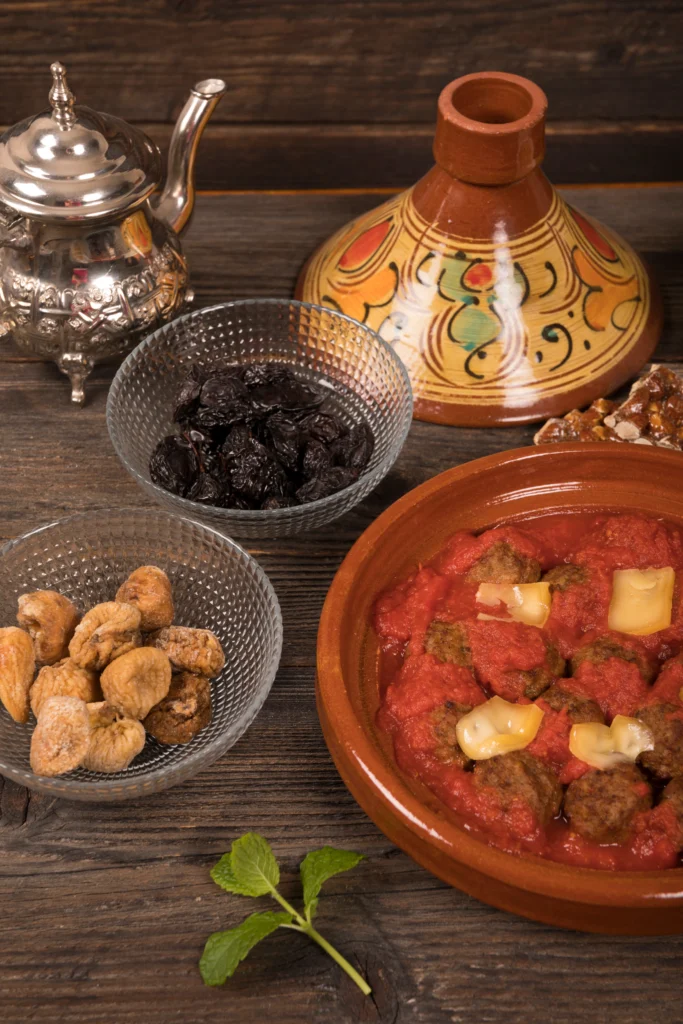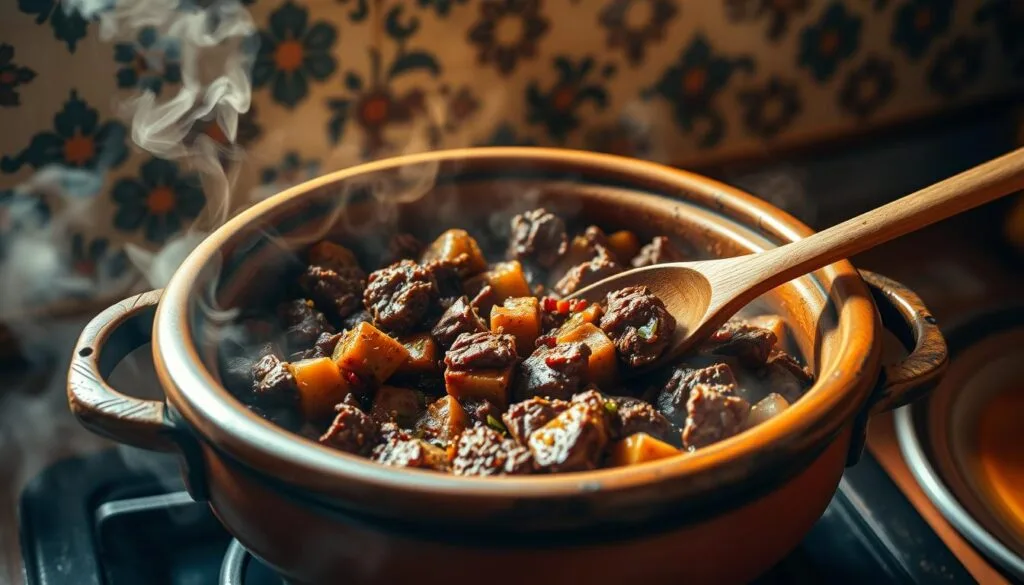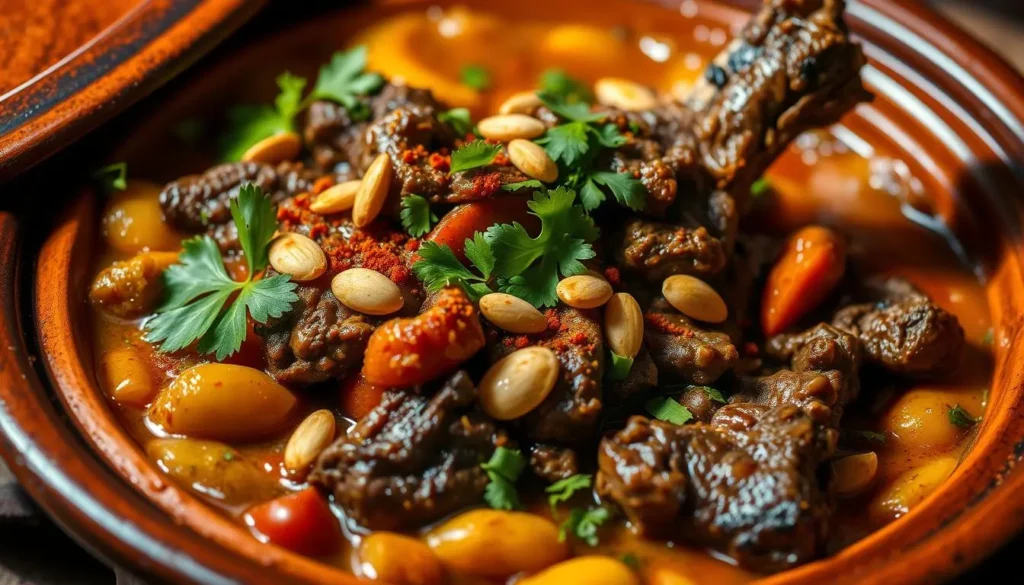How to Make Beef Tagine Moroccan Recipe
Explore the rich flavors of North Africa with our authentic beef tagine Moroccan recipe. It will take you on a journey to Morocco’s lively kitchens. This dish is more than food; it’s a cultural journey with its complex spices, tender meat, and traditional cooking methods.
Making a beef tagine needs patience, skill, and a deep love for Moroccan food. You’ll see how simple ingredients become a stunning dish. It’s a way to celebrate the rich flavors of North Africa and create a memorable meal.
Table of Contents
Key Takeaways
- Learn authentic Moroccan cooking techniques
- Master the art of slow-cooking beef tagine
- Understand the cultural significance of traditional tagine preparation
- Explore complex spice blends used in Moroccan cuisine
- Create a restaurant-quality meal at home
Understanding Traditional Moroccan Tagine Cooking
Explore Moroccan cooking traditions, where the tagine is more than a pot. It’s a symbol of North African flavors and cooking methods passed down through generations. This pottery turns simple ingredients into aromatic stews that share stories of the past.
History of Tagine Cooking Vessels
The tagine has been around for thousands of years in North Africa. Made from clay, it has a unique cone-shaped lid. This design helps steam circulate, making food tender and flavorful. It also keeps nutrients in.
Berber tribes first used these pots for cooking in the desert. They were a practical way to make meals in harsh conditions.
- Clay material ensures even heat distribution
- Cone-shaped lid captures and recirculates moisture
- Versatile for stovetop and oven cooking
Cultural Significance in North African Cuisine
Tagine cooking is more than cooking—it’s a way to share culture. Families come together to enjoy these stews. They share stories, traditions, and connect with their heritage.
Traditional Cooking Methods
Preparing a tagine involves layering ingredients and slow cooking. This turns tough meat into tender bites. It also infuses North African flavors into every mouthful.
Making a great beef stew starts with the right ingredients. Your Moroccan beef tagine needs top-notch parts to turn a simple dish into a feast.
The heart of your tagine is the beef. Choose meat that’s well-marbled for tender results. Chuck roast or shoulder are great choices for a flavorful base.
- Beef cuts ideal for tagine:
- Chuck roast
- Beef shoulder
- Short ribs
- Essential aromatic spice blend ingredients:
- Cumin
- Coriander
- Paprika
- Cinnamon
Your spice blend is key to making the stew special. Fresh spices bring out the true Moroccan taste.
| Ingredient Category | Recommended Options | Flavor Profile |
|---|---|---|
| Proteins | Grass-fed beef | Rich, deep umami |
| Aromatics | Garlic, ginger, onions | Warm, complex undertones |
| Liquids | Beef stock, tomato juice | Moisture and depth |
Quality ingredients are crucial for a great taste. Fresh, high-quality parts will make your tagine a true Moroccan dish.
“In Moroccan cooking, ingredients are not just food—they’re a celebration of culture and tradition.”
Try to use organic, local ingredients for a richer taste. This will make your beef tagine even more authentic.
Preparing Your Spice Blend for Authentic Flavor
Making an aromatic spice blend is key to Moroccan cuisine. Spices turn simple dishes into amazing meals, like beef tagine. Learning about Moroccan spices will make your cooking better and take your taste buds to North Africa.
Key Moroccan Spices
Your spice blend will have these main ingredients:
- Cumin – earthy and warm
- Coriander – citrusy and bright
- Paprika – sweet and slightly smoky
- Cinnamon – sweet and woody
- Turmeric – golden and slightly bitter
Making Ras el Hanout
Ras el Hanout, or “top of the shop” in Arabic, is a key spice mix in Moroccan cooking. Every family and area has its own recipe, making it complex and rich.
| Ingredient | Quantity | Flavor Profile |
|---|---|---|
| Cardamom | 1 tsp | Intense, aromatic |
| Nutmeg | 1/2 tsp | Warm, sweet |
| Ginger | 1 tsp | Spicy, sharp |
| Black Pepper | 1/2 tsp | Sharp, pungent |
Proper Spice Storage
Keep your spice blend fresh by storing it in airtight containers. Use glass jars with tight lids. Store them in a cool, dark place. This keeps your Moroccan dishes tasting fresh and true.
Selecting and Preparing the Right Cut of Beef

Choosing the perfect beef cut is key for a great Moroccan beef tagine. The right meat makes your stew tender and full of flavor.
For the best beef stew recipe, focus on these recommended cuts:
- Chuck roast: Perfect for slow-cooking, with rich marbling
- Beef brisket: Develops deep flavor when braised
- Short ribs: Provides exceptional tenderness and depth
When preparing beef for your Moroccan tagine, follow these essential steps:
- Trim excess fat, leaving some for flavor
- Cut meat into 1-2 inch cubes for even cooking
- Pat meat dry with paper towels to encourage better browning
Pro tip: Marinate your beef in a blend of Moroccan spices for at least 2 hours before cooking. This technique infuses the meat with rich, complex flavors characteristic of traditional Moroccan cuisine.
The secret to a perfect beef tagine lies in selecting high-quality meat and preparing it with care.

Essential Kitchen Tools and Equipment
To make a real slow-cooked stew, you need the right tools and equipment. Your tagine cooking vessel is key for a delicious Moroccan beef dish. It brings out the traditional flavors and cooking methods.
For a traditional beef tagine, you need special equipment for the best results. The right tools can make your cooking better and improve your stew’s quality.
Traditional Cookware Options
Classic tagine cooking vessels are made of ceramic or clay. They have a cone-shaped lid. These tools are great for slow, even cooking.
- Ceramic tagines with glazed interiors
- Unglazed clay tagines from Morocco
- Heavy-bottomed earthenware pots
Modern Cooking Alternatives
Modern kitchen tools also offer great options:
- Cast-iron Dutch ovens
- Enameled cooking pots
- Slow cookers with ceramic inserts
Temperature Control Tips
Getting the temperature right is key for a perfect stew. Here are tips for even cooking:
- Start with low, consistent heat
- Use a heat diffuser for ceramic tagines
- Monitor internal temperature between 180-200°F
- Allow gradual, gentle cooking for tender meat
Choosing the right tagine and knowing how to control temperature will help you make a delicious Moroccan beef tagine. It will surely please your taste buds.
Step-by-Step Cooking Process

Making a real beef tagine moroccan takes time and attention to detail. This stew needs careful steps to turn simple ingredients into a flavorful dish.
- Start by cutting the beef into 1-inch cubes for even cooking
- Season the meat well with Moroccan spices
- Heat olive oil in a heavy-bottomed tagine or Dutch oven
- Brown the meat in batches for deep, caramelized flavors
Layering ingredients is key for complex flavors in your beef tagine moroccan. Begin by sautéing onions and garlic until they’re translucent. Then, add your spice blend slowly, letting the aromatics bloom and release their oils.
| Cooking Stage | Temperature | Estimated Time |
|---|---|---|
| Browning Meat | Medium-High | 8-10 minutes |
| Slow Cooking | Low | 2-3 hours |
For a perfect stew, keep the heat low and steady. Cover your tagine and let it simmer slowly. Stir now and then and check the liquid to avoid burning.
- Use liquid sparingly – the meat will release its own juices
- Keep the lid sealed to trap moisture and concentrate flavors
- Cook until meat becomes fork-tender and falls apart easily
Your beef tagine moroccan is done when the meat is very tender and the sauce is thick and glossy. Serve it hot and enjoy the rich flavors of Moroccan cuisine.

Incorporating Preserved Lemons and Olives
Preserved lemons are key in Moroccan cooking. They turn simple dishes into amazing meals. These lemons add a special tang and depth to beef tagine that fresh lemons can’t match.
The magic of preserved lemons is their unique flavor. By pickling lemons in salt and their own juice, they become soft and full of citrus flavor. This makes Moroccan dishes even better.
Crafting Preserved Lemons at Home
Making preserved lemons is easy. You need:
- Fresh, organic lemons
- Kosher or sea salt
- Clean glass jar
- Optional spices like bay leaf or peppercorns
Selecting Premium Olives for Your Tagine
Olives are also vital in Moroccan cooking. When picking olives for your beef tagine, look for these traits:
| Olive Type | Flavor Profile | Best Used In |
|---|---|---|
| Kalamata | Rich, fruity | Beef tagine |
| Moroccan Dry-Cured | Intense, salty | Traditional recipes |
| Green Castelvetrano | Mild, buttery | Lighter tagines |
To add preserved lemons and olives to your beef tagine, add them in the last 30 minutes. This keeps their texture and flavor in the dish.
Serving Suggestions and Accompaniments
Make your Moroccan beef tagine even better by adding authentic side dishes. These sides bring out the North African flavors. Choose couscous and other sides that match the tagine’s rich, spicy taste.
Start with fluffy couscous as the base. Steam it well to soak up the tagine’s flavors and aromas. This way, the couscous becomes light and airy, blending perfectly with the sauce.
Traditional Side Dishes
Try traditional Moroccan sides to make your meal feel like a real experience. A fresh cucumber and tomato salad, or salata, adds a cool contrast. Warm flatbread or khobz is great for scooping up the sauce.
Set up the couscous as a bed for your tagine. Add fresh herbs like cilantro or parsley on top. Serve with harissa for extra spice. Your Moroccan feast will feel like a trip to Marrakech’s markets.
FAQ
What is a traditional Moroccan beef tagine?
A beef tagine is a slow-cooked stew from Morocco. It’s made in a cone-shaped clay pot called a tagine. The stew has tender beef, spices like cumin and cinnamon, and sometimes vegetables and olives. This mix creates a rich flavor typical of North African food.
What cut of beef is best for a Moroccan tagine?
Choose tough cuts like chuck roast or short ribs for the best flavor. These cuts get very tender when slow-cooked. They soak up the spices beautifully.
How long does a beef tagine typically take to cook?
It takes about 2-3 hours to cook a beef tagine. This long cooking time makes the meat tender. It also blends the spices and ingredients for a rich flavor.
Can I make a beef tagine without a traditional tagine cooking vessel?
Yes, you can! Use a Dutch oven, heavy pot, or slow cooker instead. Just make sure to cook it on low heat for a long time. This ensures the meat is tender.
What spices are essential in a Moroccan beef tagine?
Important spices include ras el hanout, cumin, coriander, and cinnamon. These spices give the dish its unique flavor.
Are preserved lemons necessary for a beef tagine?
Preserved lemons are key but not essential. They add a tangy flavor. If you can’t find them, use lemon zest as a substitute.
What are the best accompaniments for beef tagine?
Couscous is a classic choice, great for soaking up the sauce. You can also try flatbread, rice, or roasted veggies. Harissa or yogurt sauce add extra flavor.
How should I store leftover beef tagine?
Keep leftover tagine in an airtight container in the fridge for 3-4 days. The flavors get better overnight. Reheat it gently, adding a bit of liquid if the sauce is thick.

